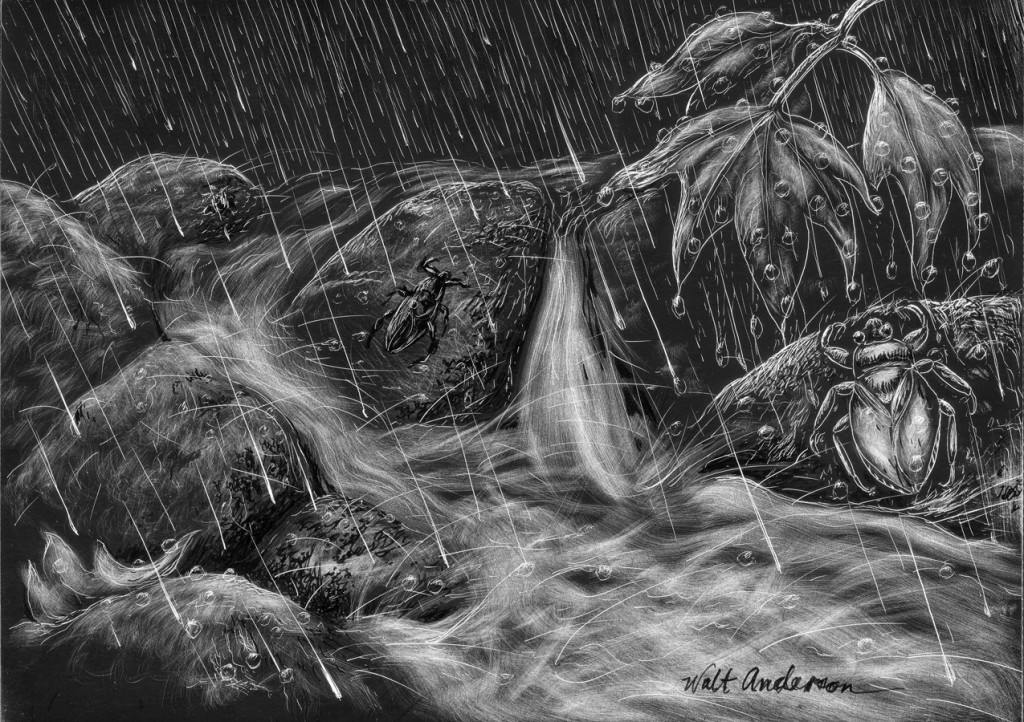Where Do Toe-biters Go When It Rains?
- Floodbug
Curiosity is a well-known field mark of a naturalist, and I have learned to indulge my curiosity when an opportunity arises. Some years ago, I stayed with friends in the Chiricahua Mountains of SE Arizona, one of the dramatic “sky islands” of the Southwest. Back in the cooler, wetter Pleistocene, the forests marched across the valleys, allowing free commerce for animals and plants among the ranges. As conditions warmed and dried, the forests retreated to higher elevations, trapping survivors on habitat islands.
Scientists have long been fascinated with these sky islands. Their curiosity, their impulses to acquire insights into how nature works, have taken some to the Chiricahuas, where a well-appointed field station offers a comfortable home base for research projects.
One mid-summer day, I arrived at the Southwestern Research Station of the American Museum of Natural History in the Chiricahuas about 4:45 pm. Dave Lytle, about to finish up his field season of research, had invited me to observe some of his experiments with Ferocious Water Bugs (Abedus herberti) and Giant Water Bugs (Lethocerus medius).
We walked behind the station to the North Fork of Cave Creek, a small stream within Madrean pine-oak woodland. A storm was approaching, thunder rolling ominously, and the mountains above were swallowed in rain. Possible flash flood weather, Dave sensed; yes, why not have a real flood rather than the one he was about to simulate in his artificial tests?
The two aquatic bugs Dave was studying belong to the same family, Belostomatidae, the largest of the true bugs. Lethocerus, more primitive than the more recently evolved Abedus, is larger and has more serious weaponry, earning the nickname “toe-biter.” Both are top carnivores within the stream ecosystem, capable of catching and eating fish and frogs. A victim is stabbed with a sharp stylus, and enzymes or digestive fluids are injected under high pressure. Digestion is extracorporeal, an out-of-body experience. Dave is eager to promote these guys as top predators, as worthy of protection as are the wolves and jaguars that some conservation groups focus on.
Abedus is a cool bug. The female lays her clutch of eggs on the back of the male, who aerates and keeps the eggs correctly moistened until they hatch. When procuring research subjects, Dave is reluctant to disturb males with their dorsal broods, so he tends to choose females as his experimental subjects. It’s hard for most humans, scientists included, to be neutral about such apparently devoted fatherhood.
Dave said the A. herberti seem to vary on different sky islands. Though the insects retain wing musculature, they don’t seem able to fly. Adoption of flightlessness could indeed isolate populations from those on other mountains, perhaps even in different watersheds in the same range.
Dave had been studying caddisflies for his PhD work, but during a particular July thunderstorm, he saw something intriguing: water bugs abandoning the creek after 5-10 minutes of torrential rainfall. The fleeing animals crawled upward, climbing vegetation and stopping when no longer pelted by the rain. A flash flood scoured the stream bottom a few hours later, wiping out most aquatic insects but having little effect on the big water bugs. Curious. The seeds of a new research project were thus planted in this scientist’s mind.
On this day, Dave had taken 12 Abedus from their artificial home in a dishpan in the lab to the experimental setup at the creek. They were put in another modified dishpan placed in a blue kiddy pool (not all science uses high-tech instruments). Fine mesh on the sides of the dishpan permitted the insects to climb easily if they should decide to leave the water. A three-sided box with a burlap-covered surface was erected above that dishpan. A stepladder surmounted this structure, with a showerhead attached at top.
A pump in the creek pushed water through hoses to the showerhead to begin the artificial deluge. Sure enough, the simulated rain storm triggered some bugs to begin climbing. After the Abedus experiments, Dave repeated the process with the larger, flight-capable Lethocerus. Dave will find that age of the bugs and stream source are variables affecting rates of retreat. Eventually it will all make sense in an evolutionary context.
I am impressed. For this young scientist, an observation raised a question, which led to experimental design, carefully controlled, yielding data that allowed informed interpretation.
Non-scientists often fail to recognize the creativity involved in field science. Curiosity and imagination drive the process. Dave loves what he is doing. His passion for the toe-biters helped sweep me into a euphoric state. Never again will I look at aquatic insects and be content with merely identifying them. Each insect is part of a story; the key is to learn to read the clues that lead us into that story.
As the last experiment concluded, the storm reached us. As I drove back over the mountains, I realized that Dave’s bugs had changed my perspective on the sky islands. Charismatic megafauna like jaguars and gorgeous birds like trogons or hummingbirds are part of the grand story of life in these ranges, but so are the little things—the caddisflies, the water bugs, the jumping spiders, the nondescript moths. If we could focus on the little things that are always in evidence, then our capacity for joy and wonder could be fed on a daily, even minute-by-minute basis.
Annie Dillard advised her readers to “collect pennies every day.” “If you cultivate a healthy poverty and simplicity, so that finding a penny will literally make your day, then, since the world is in fact planted with pennies, you have with your poverty bought a lifetime of days.”
Water bugs, toe-biters by another name, are such pennies. I vow to open the pockets of my mind to collect those coins, to accumulate riches beyond measure, and to share the wealth. A naturalist, a storyteller in love with the natural world, can thereby become a philanthropist.

